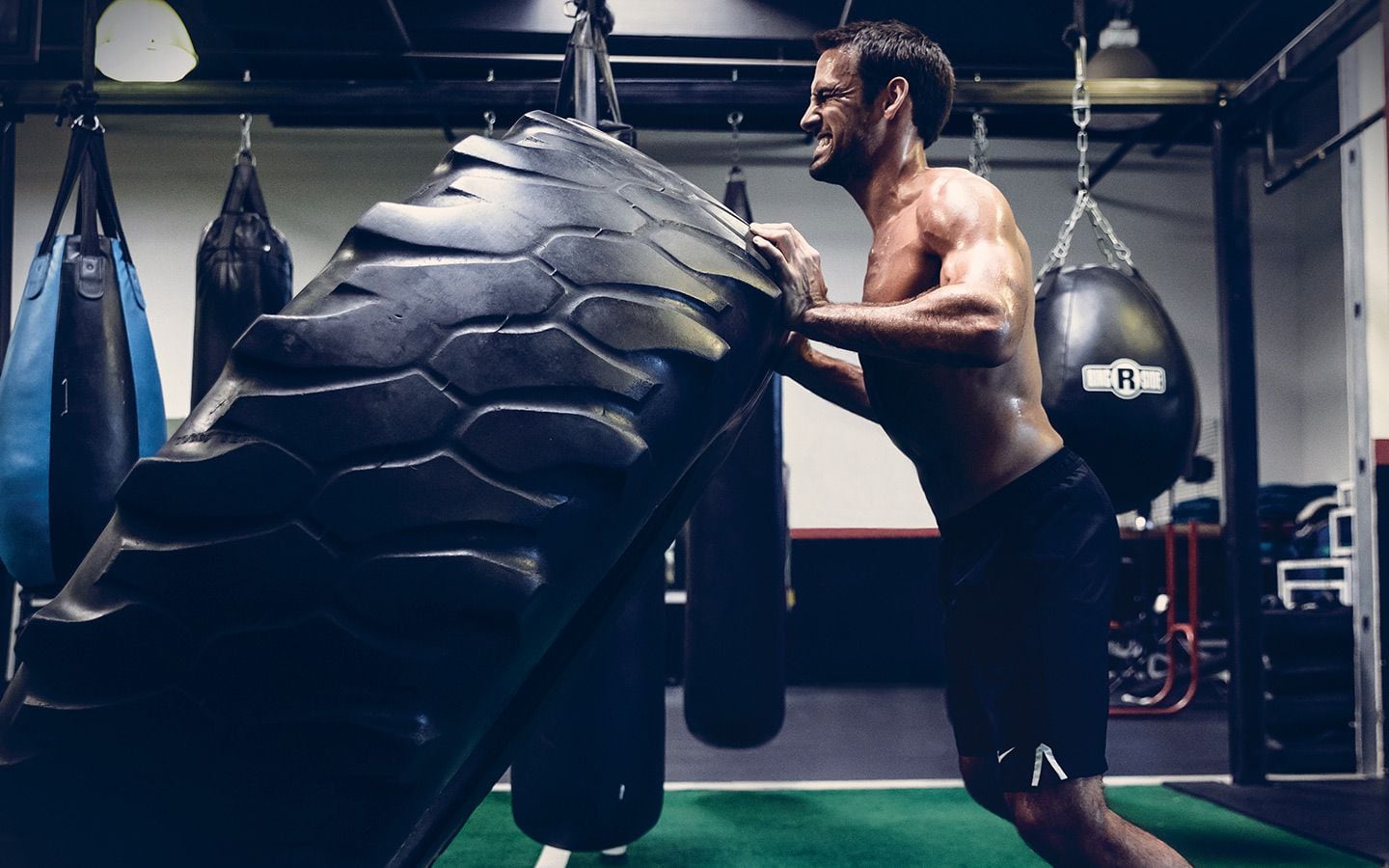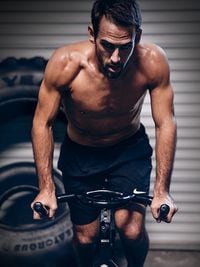I
mpassive behind a reflective visor, don’t show physical torment like other sports—soccer players running each other down like exhausted prey or the ruthless, meaty erosion of mixed martial arts. But racing a motorcycle at the professional level is brutal, agonizing work. In a single 30-minute heat, a motocross pro will burn as many calories as two marathoners and experience twice the G-forces of a fighter pilot in full vertical climb. A MotoGP rider will wrestle a 350-pound bike to the pavement hundreds of times per race at average speeds of more than 100 mph and lose a half-gallon of sweat in the process. Competitors at this level are nearly machines themselves, though of a different sort, depending on the discipline. We broke down the key specs and characteristics of two drastically different types of elite racer—the top-gun MotoGP speedster versus the airborne, dirt-slinging motocross athlete—to get a sense of that fuzzy border at the edges of human effort.
Professional riders come in all shapes and sizes, but according to the numbers, MotoGP riders are the smaller, slimmer athletes. Looking at the personal stats of the 10 top-ranked riders from both disciplines shows the “average” elite MotoGP racer stands just less than 5-foot-8 and weighs 143 pounds, while a composite rider built from the best Motocross 450-Class competitors would weigh 157 pounds at around 5-foot-10. The rule of thumb for calculating additional body weight for adult men above 5 feet tall is 5 to 7 pounds per extra inch of height. Here, the 14-pound weight difference for two extra inches of height hits the upper limit of that benchmark. This suggests the motocross athlete is packing more muscle mass, which is relatively heavier.
"Motocross riders tend to have a bit more definition and bulk," confirms renowned pro coach Aldon Baker, who has trained motocross greats like Ryan Dungey and Marvin Musquin, as well as the late American MotoGP rider Nicky Hayden at his Baker's Factory compound in Florida. "Physically, the MotoGP rider needs to be leaner with not as much muscle because, while motocross riders have to muscle the bike around more, a GP rider has to stay aerodynamic."
A lot of the motocross rider’s extra mass is focused in the legs. While MotoGP riders are like jockeys, nimbly shifting and leaning with the bike’s momentum to cut through the air, motocross athletes ride a significantly lighter machine but are constantly wrestling it around the track and are always moving along the spectrum between an upright position and sitting.
“If you look at how many times a motocross rider squats during a race, it’s insane,” Baker says. “Watch the rider’s movement throughout a lap—it’s up-down, up-down, up-down. There are so many more movements involved in motocross, whereas MotoGP is more about precision, so the motocross athlete is going to be physically stronger and more muscular.”
The downside of extra bulk, of course, is sluggish acceleration. It’s harder to motivate a heavy bike-and-rider combo than a lighter one. And while the MotoGP rider has a mechanical advantage over the motocross athlete thanks to a bigger, faster motorcycle, pure acceleration is also far more important in Grand Prix racing. The rider does his part to goose the power-to-weight advantage in the only way he can: by staying as trim as possible.
“We always had to watch Nicky’s [Hayden] weight because he was typically a bigger rider than everybody else in MotoGP—he needed to be a lot leaner because his teammate, Dani Pedrosa, was so small that his acceleration was phenomenal,” Baker says. (According to current listed stats, Pedrosa clocks in at just 112 pounds, which is within the normal weight range for a 13-year-old American teenager.) “In Formula 1 or NASCAR, they weigh the drivers then add weight to the cars to make it balanced. It doesn’t work that way with bikes. If the rider can be 30 pounds lighter, it really helps.”
While there’s a marked difference between MotoGP and motocross racing formats and styles—MotoGP riders race a roughly 45-minute sprint at speeds up to 217 mph, while motocross athletes compete in a pair of 30-minute (plus two laps) “motos” and rarely break 50 mph—Baker says the two types of athletes are nearly identical in terms of cardiovascular endurance, with similar training zones and max heart rates in the 180s. Still, he says, the bigger and more muscular athlete will usually have the endurance advantage over a smaller, leaner competitor.
“When it came to physical strength, meaning fatigue, Nicky was naturally stronger and could go longer,” Baker says. “Pedrosa used to get tired—his arms were dying at the end because of the braking.”
Baker says that the key failure point for any competitive motorcyclist is the arms—specifically, the forearm pump that happens with repeated braking.
“The biggest thing you do not mess with in either sport is the arms,” Baker says. “No curls! You never want to build up the biceps or the forearms for motorcycles; if they load up, you’re done. When that little ball in your forearm starts contracting, then gets rock hard, you can’t brake—that’s the worst nightmare for a motorcycle guy. We’re always doing exercises to stretch relieve any loading in the arms and forearms.”
An interesting point of difference between the two sports is how each athlete is forced to adjust as the race wears on and fatigue sets in. For the MotoGP rider, “The course doesn’t change,” Baker says. “You’re not going to come around the bend to find a big hole somewhere or that the track got steeper.”
What changes is the bike: As the tires are scrubbed away, the grip gets looser and the balance of the bike changes dramatically, requiring the rider to use more finesse even as he tires physically. In motocross, it’s the opposite: Dirt riding is easier on the tires, so the bike essentially stays the same while the slick, muddy course is constantly morphing. “You still have to muscle the bike to maintain the pace,” Baker says, “but under conditions that are changing every lap.”
All motorcycle racing takes a toll on the body, whether it’s from heat, physical and mental exertion, or a crash. The most significant physical stress factor experienced by any racer in any discipline is cumulative G-force—the “push” on the body that comes from acceleration. But MotoGP and motocross, with their divergent styles, punish athletes’ bodies in different ways. The MotoGP rider experiences the most G-forces under braking, scrubbing an immense amount of speed in milliseconds, while a motocross athlete is most affected during jumps—either the compression before launching or while landing.
To get a sense of the types of forces withstood by each athlete, we reached out to Michael Ford, president of LITPro, a rider analytics company used by multiple teams in Lucas Oil Pro Motocross and Monster Energy Supercross. For a typical motocross lap in competition, LITPro data shows the rider experiences average G-forces in the range of 2.7 to 2.9 G, excluding airtime. However, peak G-forces, such as when the rider lands a big jump, are massive (if short-lived): anywhere from 10 to 20 G. As a point of comparison, elite fighter pilots maintain around 9 G during a vertical climb.
Data is harder to come by for MotoGP; GP teams are notoriously secretive about their analytics, and while the LITPro tracker is helmet-mounted for dirt bike disciplines, the device is attached to the motorcycle itself during road-course testing. “The vibration from the bike artificially inflates [G-force data] enormously,” according to Ford.
However, some extrapolation is possible thanks to helmet-mounted LITPro data from a talented amateur rider on 1,000cc sportbike doing MotoGP-style runs around Auto Club Speedway in Fontana, California. This data shows average G-forces in the 1.7 to 1.9 range and peak G between 3 and 4; adding about 15 percent to the top end—what Ford describes as a fair difference between a top amateur and an elite pro, according to much of his data—the numbers suggest an average of 2.0 to 2.2 G per lap (no airtime) and a gravitational force peak in the 4 to 6 G range. So while the speeds are up to four times as fast in MotoGP, motocross athletes seem to put up with more physical punishment.
“Motocross is a lot more movement, hitting things hard—it beats you up more,” Baker says.
Baker is a big fan of yoga for all disciplines. “It’s especially good for injury prevention because they’re going to crash at some point, and if you’re more flexible you tend to do better when you go down,” he says. It’s especially important for MotoGP riders because the need to maintain aerodynamic efficiency forces the rider into a tight position for long stretches of time, which is hard on the lower back.
“MotoGP riders are always working at a lean angle, off one leg, but they still have to steer and maintain a change of direction on a heavier bike,” Baker says. To help with this, Baker focuses on what he calls a type of “angular strength,” which helps a rider maintain stability and force production through awkward body positions. In the gym, that might mean pushups with balance-ball hip rotations, side lunges with shoulder front dumbbell raises, or suspension-cable chest presses that include a pike on a medicine ball.
“With the motocross guys, you have some lean angle, but it’s not as crazy as GP, so I try to incorporate a lot of the semi-squat positioning,” Baker says. That means exercises like seated shoulder press, wall squats with side- and front-shoulder dumbbell raises, kneeling on a balance ball with dumbbell shoulder raises, and chest presses with weighted ball leg raises.
Both disciplines, Baker says, require extensive cardio conditioning, which comes in many forms: running, cycling, swimming, rowing, skiing, and stair-climber machines.
One key difference, Baker says, is the MotoGP athletes’ series-imposed limitations on actually riding the racebike: Riders are given only four practice sessions before qualifying. With so much time off the machine, Baker would fill out the MotoGP training program with dynamic elements like eyesight and vision exercises to improve reaction time, plyometrics, Supermoto, flat-track, and even motocross riding.
“In motocross, we have our own tracks, we have the bike availability, so we hone our skills a lot more from riding,” Baker concludes. “We stick to the basics: Do we have our strength in check? Do we have our flexibility in check? Do we have our cardio in check? But the riding of the bike is most of it.”



















/cloudfront-us-east-1.images.arcpublishing.com/octane/VZZXJQ6U3FESFPZCBVXKFSUG4A.jpg)
/cloudfront-us-east-1.images.arcpublishing.com/octane/QCZEPHQAMRHZPLHTDJBIJVWL3M.jpg)
/cloudfront-us-east-1.images.arcpublishing.com/octane/HXOUJXQWA5HBHGRO3EMJIGFMVI.jpg)

/cloudfront-us-east-1.images.arcpublishing.com/octane/3TIWWRV4JBBOLDVGRYECVVTA7Y.jpg)
/cloudfront-us-east-1.images.arcpublishing.com/octane/KIX5O23D5NAIBGFXBN3327DKZU.jpg)
/cloudfront-us-east-1.images.arcpublishing.com/octane/7GJYDUIPXRGMTMQKN6ONYOLBOU.jpg)
/cloudfront-us-east-1.images.arcpublishing.com/octane/MUQLOVLL2ZDGFH25ILABNBXKTI.jpg)
/cloudfront-us-east-1.images.arcpublishing.com/octane/TNOU5DNE2BC57MFPMGN2EIDXAM.jpg)
/cloudfront-us-east-1.images.arcpublishing.com/octane/GTCXACQGJ5HAPDTGWUQKDEH44E.jpg)
/cloudfront-us-east-1.images.arcpublishing.com/octane/S35YGSEMEZB4BLTDJTSZPF4GLA.jpg)
/cloudfront-us-east-1.images.arcpublishing.com/octane/5UOT6HPX2JFMRJAX6EH45AR4MQ.jpg)
/cloudfront-us-east-1.images.arcpublishing.com/octane/OKWOJWAKP5EP3OACCRRWPCIX2Q.jpg)
/cloudfront-us-east-1.images.arcpublishing.com/octane/2WF3SCE3NFBQXLDNJM7KMXA45E.jpg)
/cloudfront-us-east-1.images.arcpublishing.com/octane/G4MG6OUCJNBSHIS2MVVOTPX65E.jpg)
/cloudfront-us-east-1.images.arcpublishing.com/octane/IIGGWFOTOJGB7DB6DGBXCCMTDY.jpg)
/cloudfront-us-east-1.images.arcpublishing.com/octane/QSTCM6AVEZA5JJBUXNIQ3DSOF4.jpg)
/cloudfront-us-east-1.images.arcpublishing.com/octane/U4I7G625B5DMLF2DVIJDFZVV6M.jpg)
/cloudfront-us-east-1.images.arcpublishing.com/octane/B6XD6LS6IVCQPIU6HXDJSM3FHY.jpg)
/cloudfront-us-east-1.images.arcpublishing.com/octane/ICL63FEDDRDTTMINYICCEYGMDA.jpg)
/cloudfront-us-east-1.images.arcpublishing.com/octane/FCGZHQXRBZFLBAPC5SDIQLVF4I.jpg)
/cloudfront-us-east-1.images.arcpublishing.com/octane/WNOB6LDOIFFHJKPSVIWDYUGOPM.jpg)

/cloudfront-us-east-1.images.arcpublishing.com/octane/X33NU3E525ECRHXLNUJN2FTRKI.jpg)